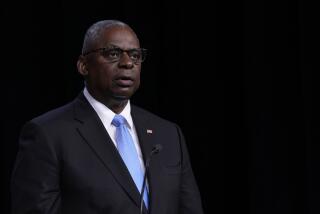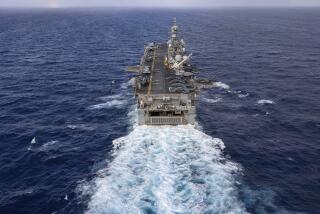U.S. Seeks to Devise Military Plan for New Iraq Crisis : Strategy: The Administration wants to pry loose a team of U.N. arms inspectors without resorting to use of force.
WASHINGTON — The Bush Administration struggled Wednesday to develop a new military plan that could pry loose a team of U.N. arms inspectors from Iraqi control without immediately resorting to use of force, according to senior U.S. officials.
Wary of pursuing a course that might quickly lead to new air strikes against Iraq, key aides to President Bush were seeking to deliver the kind of threat that would persuade Baghdad to back down without running the risk that defiance could lead to war, the officials said.
But as Bush met Wednesday with his senior national security advisers, there were clear signs of frustration over what officials said appeared to be scant options for a more measured ultimatum.
“The discussion centers on whether you can or you can’t put the pressure on the Iraqis” without resorting to explicit threats of hostilities--”and if so, how,” one Administration official said.
It was not immediately clear how the policy discussion would be affected by a report late Wednesday that Iraq had offered to free the 44 U.N. inspectors, providing they agreed to sign for all documents in their possession. The offer was contained in a letter delivered to U.N. officials by an Iraqi diplomat.
At the Pentagon, meanwhile, military planners were preparing for an expected deployment of at least 50 more warplanes and a number of Navy ships to back up U.S. and U.N. demands that Iraq comply with the arms inspection program. The plan does not include the dispatch of ground forces, a senior Pentagon official said.
Bush was briefed on the plan Wednesday morning by Defense Secretary Dick Cheney and Gen. Colin L. Powell, chairman of the Joint Chiefs of Staff. But the President has not yet given the order to move the forces, officials said, and a senior officer dismissed the notion that any military action was imminent.
“There needs to be a series of things that happen before military responses would be called for,” the official said.
While the Pentagon wrestled with the use-of-force dilemma, the White House took pains to tone down its forceful rhetoric in an apparent effort to dampen expectations that the United States might be preparing a rapid and aggressive military move. “I’m trying to give it to you . . . as unemotionally as possible,” said White House spokesman Marlin Fitzwater.
Bush, who for more than a week has almost daily raised the specter of military action, refrained from all but the mildest public comment.
The new policy predicament arose at least in part because of the success of the Administration’s previous plan to overcome Iraqi interference with U.N. inspectors.
By threatening to send warplanes as armed escorts, the Administration forced Iraq to guarantee to the Security Council that it would no longer impose limits on U.N. helicopter missions. But when his officials suddenly shifted the focus to the U.N. inspectors in the Baghdad parking lot, Iraqi President Saddam Hussein presented the Administration with a new challenge for which it could devise no immediate military response.
“It’s created a problem of a different sort,” an Administration official said of the new confrontation, in which Iraqi officials have refused to permit U.N. inspectors to take possession of sensitive documents about Iraq’s nuclear weapons program.
The White House said the new assurance from Iraq meant that the United States would delay until at least this weekend any dispatch of the helicopter escorts and would call off the plan if Baghdad were to abide by its pledge to allow unrestricted U.N. helicopter inspections.
With experts skeptical that such escorts could overcome the problem of on-the-ground intransigence, Administration officials said they could conceive of no threat, short of the actual use of military force, that might compel Iraq to relinquish the documents.
Rep. Les Aspin (D-Wis.), chairman of the House Armed Services Committee, proposed in a television interview Wednesday morning that the United States consider the “actual use of ground troops to go with the inspectors so you don’t have this situation that we have now with the standoff that we have in the parking lot.”
But a senior Pentagon military official said Wednesday night that no such option was under consideration. And another senior military source ruled out the notion that U.S. forces would mount a mission to rescue the detained inspectors. “The detainees are a U.N. issue,” the official said. “We are a long ways from . . . getting involved in that.”
Bush has said repeatedly the United States is prepared, if necessary, to use force to compel Iraq to comply with terms of the Gulf war cease-fire agreement. But he has stopped short of delivering an ultimatum; advisers said he was not yet ready to order renewed air strikes against Iraq.
But there were clear indications that the U.S. military is moving to build up its forces in the Gulf region to add to American striking power if such action is authorized.
About 200 U.S. warplanes are based in the region as well as 26 Navy ships, including two aircraft carrier battle groups and a Marine Corps amphibious assault unit aboard the helicopter carrier Peleliu. Officials said these forces will be significantly enhanced, but they would not specify the size of the additional deployment. At the same time, a senior Pentagon official said that Air Force Lt. Gen. Charles A. Horner, who oversaw the massive allied air campaign in the Gulf War, will be returning to Saudi Arabia within the next few days.
Patriot air-defense missiles began arriving in Saudi Arabia late Wednesday and will become operational “within a few days,” officials said. The Patriots are being put in place to protect Saudi cities against possible Iraqi Scud missiles, as well as to defend the air bases from which U.S. combat aircraft would operate.
More to Read
Sign up for Essential California
The most important California stories and recommendations in your inbox every morning.
You may occasionally receive promotional content from the Los Angeles Times.










